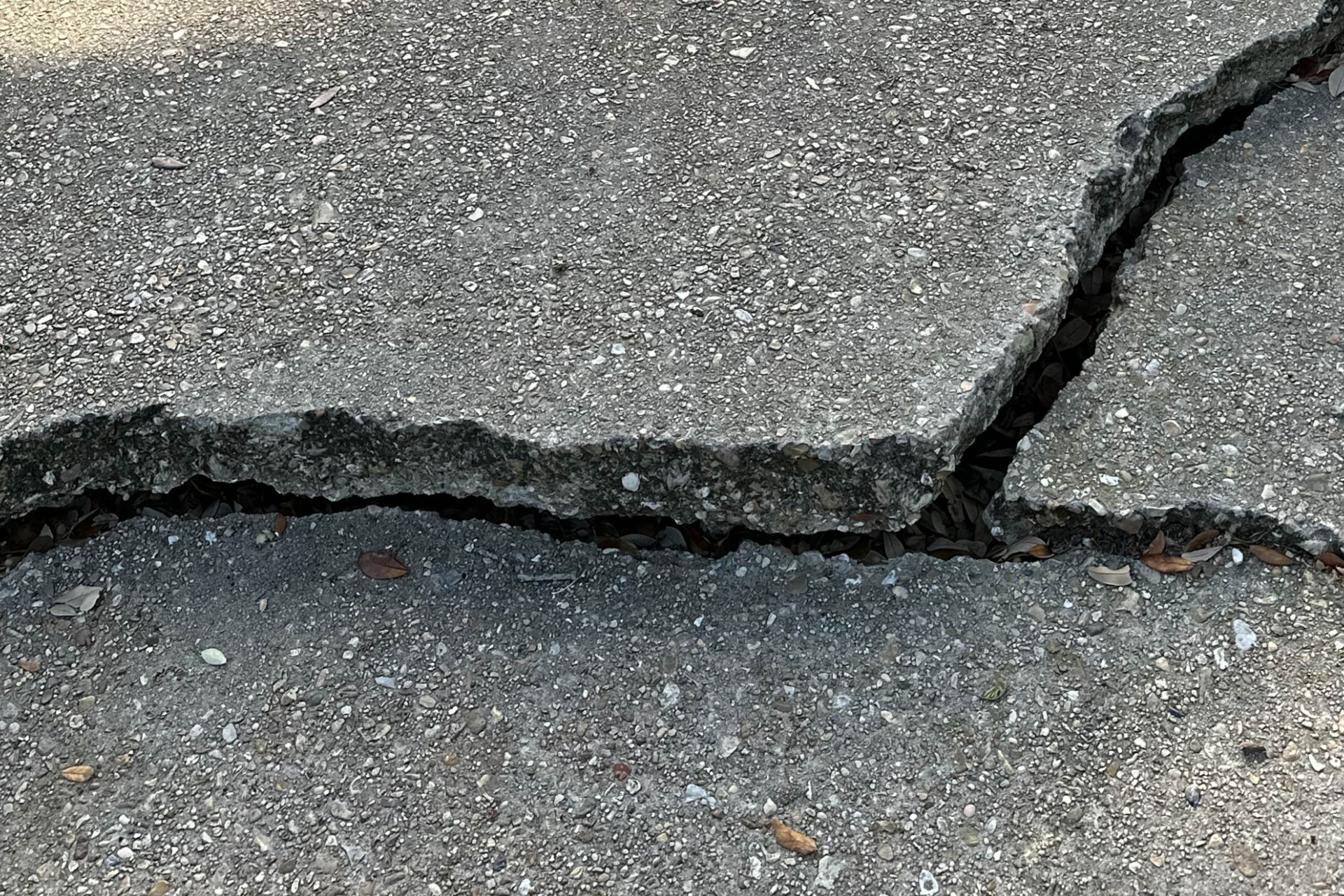Concrete lifting or leveling is a process used to correct uneven or sunken concrete surfaces, such as sidewalks, driveways, or patios to restore functionality and aesthetics.
It involves injecting a specialized material, often polyurethane foam or a cement slurry, beneath the concrete slab. This material expands to fill voids and raises the slab to its original position, effectively leveling the surface.
This method is preferred over traditional methods like mudjacking because it’s less invasive, quicker, and offers long-lasting results.
Assessing Driveway Damage
Before initiating any repair, it’s essential to assess the extent of damage your driveway has incurred. Weather impacts, including freeze-thaw cycles, excessive rain, and extreme temperature fluctuations, can cause concrete to crack, heave, or sink.
Identifying these patterns is important because they directly influence the approach you’ll take for repairs.
The composition and age of the concrete and the quality of the initial installation are factors that determine the resilience and longevity of your driveway.
It’s important to analyze the concrete’s current state—is it merely surface-level cracking or are there deeper structural issues at play? This analysis will guide the repair strategy, focusing on not just aesthetics but ensuring the longevity of the repair work.
Choosing the Right Method
After assessing the extent of damage, you can select the most appropriate method for lifting your concrete driveway, focusing on both effectiveness and efficiency.
Your decision should hinge on a detailed cost comparison and an understanding of each method’s effectiveness. Two prevalent techniques are mudjacking and polyurethane foam injection.
Mudjacking, the traditional method, involves pumping a cement-based slurry beneath the concrete to raise it. This option is often less expensive upfront but may not provide the same longevity as alternative methods.
Polyurethane foam injection, on the other hand, is a more modern approach that injects high-density foam under the concrete.
While the initial cost may be higher, its durability and effectiveness in a wider range of temperatures can make it more cost-effective in the long run.
Choosing the right method involves weighing these factors carefully. Consider not only the immediate cost and repair effectiveness but also the long-term sustainability of each option.
Preparation Steps
To ensure successful concrete driveway lifting, carefully inspect the area for any obstructions or utilities that could interfere with the process. This initial step is critical as it ensures the safety and smooth execution of the lifting operation.
Begin by marking any underground utilities to avoid damaging them during the process. Clear the workspace of debris, vegetation, or movable objects that could hinder access or machinery movement.
To ensure a seamless and long-lasting lift, opt for high-quality, durable materials compatible with the existing concrete.
This choice should be based on the driveway’s current condition and the specific requirements of the lifting method you’ve selected.
Weather considerations are equally important. Schedule the lifting on a day with favorable weather conditions to prevent unexpected delays or complications.
Ideal conditions include a dry, mild day as extreme temperatures can affect the curing process of materials used and the overall outcome of the lift.
Lifting and Leveling Techniques
After preparing the site, you’ll use specific lifting and leveling techniques designed to correct uneven surfaces with minimal disruption to the existing concrete.
These methods aren’t only effective but also aim to extend the lifespan of your driveway by addressing underlying issues and surface imperfections.
The key to a successful adjustment lies in a combination of precise actions and technical strategies, including:
- Soil stabilization: Before any lifting is done, the ground beneath the concrete must be stabilized. This process involves injecting a polyurethane foam or similar material into the soil, which expands and hardens, providing a solid foundation. This step prevents future settling and unevenness.
- Slab jacking: This technique involves drilling small holes into the concrete slab and then pumping in a mixture, typically a slurry of cement, sand, and water, under pressure. The mixture fills voids in the soil and raises the slab back to its original level.
- Polyurethane foam injection: This is similar to slab jacking but uses a lightweight polyurethane foam. The foam expands quickly, filling voids and lifting the concrete with precision and less weight, reducing the risk of additional soil compression.
- Crack filling: After leveling, any cracks or joints are filled with a flexible sealant. This step is essential for preventing water infiltration, which can cause further damage.
These techniques, when applied correctly, offer a durable solution to uneven concrete, restoring your driveway’s functionality and appearance without the need for complete replacement.
Aftercare and Maintenance
To ensure the longevity of your driveway, you must implement a comprehensive aftercare and maintenance routine following the lifting and leveling process.
Weather protection plays a key role in preserving your driveway’s integrity over time. This involves applying high-quality sealants that serve as a barrier against water penetration, freeze-thaw cycles, and UV radiation.
These elements can significantly accelerate the deterioration process by causing expansion and contraction in the concrete, leading to cracks and voids.
Crack sealing is an essential preventive measure. It’s not just about addressing visible damage; it’s about proactively identifying and sealing potential weak points before they evolve into significant issues.
Regular inspection for hairline cracks or separations at the joints will guide you in applying the right type of sealant, ensuring a tight seal that prevents water ingress and further damage.
Adhering to these aftercare guidelines significantly enhances the structural integrity and appearance of your concrete driveway.
By incorporating weather protection measures and diligent crack sealing, you’re not merely extending the lifespan of your driveway but also optimizing its performance and aesthetic value.
This proactive approach to maintenance ensures your driveway remains functional and visually appealing for years to come.

